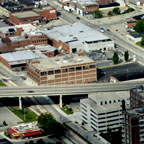
Does your community have vacant or underutilized properties? Are you tired of seeing these properties waste space? The good news is these eyesores are attractive redevelopment opportunities. For example, a capped landfill site was converted into a soccer field, and an abandoned manufacturing site was redeveloped into an outdoor amphitheater.
Brownfield properties pose unique challenges, including financial complexity and long-term liability due to environmental risks. Fortunately, there are several tools available to assist in evaluating risks, defining the uncertainties, and managing these properties to realize the redevelopment goals of public and private stakeholders.
The U.S. Environmental Protection Agency (EPA) defines a brownfield as “real property, the expansion, redevelopment, or reuse of which may be complicated by the presence or potential presence of a hazardous substance, pollutant, or contaminant.” The U.S. EPA estimates more than 450,000 brownfield properties exist throughout the country, and the Illinois EPA suggests they’re present in almost every community. These brownfield properties reduce local tax revenue, contribute to neighborhood deterioration, and add to the pressures of urban sprawl.
State and federal financial grant and loan programs can assist municipalities and developers defray costs and bridge the financial gap between constructing on a brownfield site and developing a greenfield property. One excellent program, the U.S. EPA Assessment Grant, provided approximately $76 million in funding in 2005 for municipalities throughout the country to inventory, investigate, and prioritize brownfield properties. More than 16 Illinois communities have taken advantage of U.S. EPA assessment or cleanup grants, with many municipalities receiving multiple grants.
The state of Illinois has several brownfield funding tools, most notably the Municipal Brownfield Redevelopment Grant Program. This program provides local governments with funding for contamination determination, assessment, and cleanup for brownfield redevelopment. The program provides each eligible municipality with up to $240,000 of funding, with a 30 percent match by the municipality. In addition to single properties, the program funds activities to assess multiple brownfield properties. This can be helpful for redevelopment sites that aren’t obtrusive brownfield sites.
Successful redevelopment of brownfield properties also requires a technical approach that integrates engineering and construction aspects of site development with the environmental conditions of the property. Significant cost savings and accelerated construction schedules often are achieved by incorporating environmental remediation with site improvements. For example, a new parking lot also can act as an environmental cap, utility corridors can be positioned to avoid contamination, and building foundations and site grading can be designed to reduce contaminated soil management costs. The environmental conditions of a property, if properly managed, don’t have to restrict the development potential of the site.
To reduce the risks and liability of development, uncertainties are defined through creative strategies such as environmental insurance products, probability analyses, and sound transaction agreements. Once the uncertainties are defined, they can be managed as part of the economic decision-making process required for every development project.
Brownfield redevelopment requires a cooperative partnership between the municipality, developer, and local community. While developing environmentally impacted property has its challenges, the rewards can be significant. In addition to protecting public health and the environment, revitalized brownfield property creates economic growth, reduces unemployment, and often provides a catalyst for future growth. IBI

